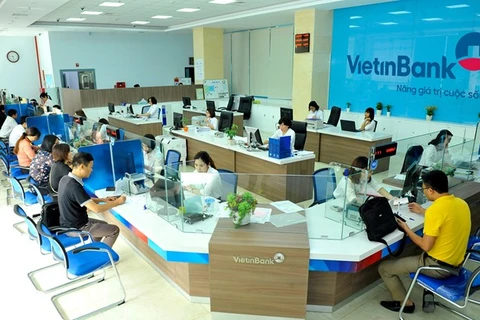 Banks earmark abundant capital sources to support businesses in the year-end months (Photo: VietnamPlus)
Banks earmark abundant capital sources to support businesses in the year-end months (Photo: VietnamPlus) Hanoi (VNA) - In recent days, many domestic banks have lowered both deposit and lending interest rates for short-term VND loans to support businesses in the year-end months.
Banks earmark abundant capital sources to support businesses in the year-end months (Photo: VietnamPlus)
The move has been highly evaluated by enterprises as sectors have been facing a range of difficulties in production and business. However, the interest rate cut has yet to be carried out on a large scale, hence a number of enterprises have yet to get access to preferential loans.
Welcome the peak year-end season
Currently, commercial banks have tightened credit for real estate as well as risky sectors, and restructured capital sources to meet regulations on reducing the short-term capital for medium and long-term loans, but still offered soft credit packages for enterprises during the year-end peak business season.
Typically, the Asia Commercial Joint Stock Bank (ACB) earmarked a credit package worth 5 trillion VND (216.5 million USD) to provide floating capital with an interest rate of 7.5 percent per annum.
The An Binh Commercial Joint Stock Bank (ABBANK) offered 2.5 trillion VND (108.3 million USD) for businesses with a fixed lending interest rate of 7.8 percent per annum in the first three months or 8.3 percent per year in the first six months.
Meanwhile, the Vietnam Export Import Commercial Joint Stock Bank (Eximbank) put aside 4 trillion VND (173.3 million USD) for small- and medium-sized enterprises (SMEs) with an interest rate from 6.99 percent per annum.
[Banks race to lower interest rates – “Headwind” amid credit season]
Nguyen Quoc Hung, Director of the Credit Department under the State Bank of Vietnam (SBV), said outstanding loans for SMEs had reached almost 1.48 quadrillion VND by the end of the third quarter of 2019, up 12.9 percent from the end of 2018. Worthy of note, outstanding loans for SMEs increased higher than the average credit growth of the economy.
In the coming time, the SBV will continue to deploy monetary and credit solutions to fully and timely meet SMEs’ demands for capital. Besides, the central bank will also coordinate with relevant ministries and sectors to comprehensively implement policies to assist businesses as stipulated in the Law on Support for Small- and Medium-sized Enterprises, including capital access through different funds.
Therefore, on December 19, the SBV asked commercial banks to revise down deposit and lending interest rates to make it easier for enterprises to get access to capital sources.
Accordingly, the maximum short-term lending interest rate for VND loans for agricultural and rural development, export, supporting industries, SMEs and firms using hi-tech has been reduced from 6.5 percent to 6.0 percent per annum.
State-owned commercial banks such as Joint Stock Commercial Bank for Foreign Trade of Vietnam (Vietcombank), Joint Stock Commercial Bank for Investment and Development of Vietnam (BIDV), Bank for Agriculture and Rural Development of Vietnam (Agribank) and Vietnam Joint Stock Commercial Bank for Industry and Trade (VietinBank) all cut their lending interest rates for the prioritized sectors by 0.5 percent.
The Vietnam Maritime Commercial Joint Stock Bank (MSB) also lowered the lending interest rate by 2 percent for enterprises and business households. In particular, the bank cut the lending interest rate for agricultural production and livestock breading by up to 3.6 percent.
Yet to benefit many businesses
While highly evaluating the lending interest rate cut, many enterprises said the policy has just focused on a number of prioritized fields and many businesses have still found it hard to approach this preferential capital source.
A representative of a transport company said although banks announced their lending interest rates at 7 percent per annum, several borrowing contracts of the company have interest rates of between 10-11 percent per year.
A leader of the Vietnam Association of Small and Medium Enterprises (VINASME) said a number of companies have yet to get access to soft loans offered by the banks because they have yet to accumulate many assets, have no collateral assets or their financial systems and information transparency have yet to reach the set standards.
Finance expert Nguyen Tri Hieu said only major banks with financial potential have cut lending interest rates while small banks have responded to the policy but their interest rates remained higher than the average level. Hence, the lending interest rates are unlikely to bring about great effects as expected by businesses at a time when enterprises have high demands for capital during the year-end months./.























